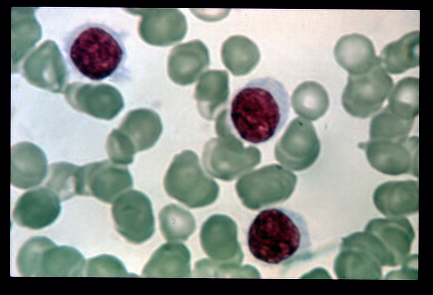Hairy cell leukemia (patient information): Difference between revisions
No edit summary |
No edit summary |
||
| Line 1: | Line 1: | ||
'''For the WikiDoc page for this topic, click [[Hairy cell leukemia|here]]''' | '''For the WikiDoc page for this topic, click [[Hairy cell leukemia|here]]''' | ||
{{Infobox_Disease | | |||
Name = {{PAGENAME}} | | |||
Image = Hairy_cell_leukemia.jpg | | |||
Caption = | | |||
DiseasesDB = 5589 | | |||
ICD10 = {{ICD10|C|91|4|c|81}} | | |||
ICD9 = {{ICD9|202.4}} | | |||
ICDO = 9940/3 | | |||
OMIM = | | |||
MedlinePlus = | | |||
MeshID = D007943 | | |||
}} | |||
{{SI}} | {{SI}} | ||
'''Editor-in-Chief:''' [[C. Michael Gibson]], M.S.,M.D. [mailto:mgibson@perfuse.org] Phone:617-632-7753; '''Associate Editor-In-Chief:''' Jinhui Wu, M.D. | |||
==Overview== | ==Overview== | ||
Hairy cell leukemia is one type of [[B-cell lymphoma]]. It is a rare disease, about 1,000 people in the United States are diagnosed each year. Patients with Hairy cell leukemia tend to be older in general. The cells are small B lymphocytes with projections coming off them that give them a "hairy" appearance. They are always found in the bone marrow, spleen and circulating in the blood. Usual symptoms include unexplained [[weight loss]], [[fever]], [[night sweat]] and so on. Like other [[Non-Hodgkin lymphoma]], [[biospy]] may be the best method for diagnosis. For Hairy cell leukemia is slow-growing, some patients may never need treatment. An enlarging spleen or dropping blood counts are the usual reasons to begin treatment. Treatments include radiation therapy, chemotherapy, bone marrow or peripheral blood stem cell transplantation and a combination of them. | Hairy cell leukemia is one type of [[B-cell lymphoma]]. It is a rare disease, about 1,000 people in the United States are diagnosed each year. Patients with Hairy cell leukemia tend to be older in general. The cells are small B lymphocytes with projections coming off them that give them a "hairy" appearance. They are always found in the bone marrow, spleen and circulating in the blood. Usual symptoms include unexplained [[weight loss]], [[fever]], [[night sweat]] and so on. Like other [[Non-Hodgkin lymphoma]], [[biospy]] may be the best method for diagnosis. For Hairy cell leukemia is slow-growing, some patients may never need treatment. An enlarging spleen or dropping blood counts are the usual reasons to begin treatment. Treatments include radiation therapy, chemotherapy, bone marrow or peripheral blood stem cell transplantation and a combination of them. | ||
==See also== | ==See also== | ||
*[[B-cell lymphoma (patient information)|B cell lymphoma]] | |||
== | ==Source== | ||
http://www.cancer.org/docroot/CRI/content/CRI_2_4_4X_Treatment_of_Hairy_Cell_Leukemia_HCL_62.asp?sitearea= | http://www.cancer.org/docroot/CRI/content/CRI_2_4_4X_Treatment_of_Hairy_Cell_Leukemia_HCL_62.asp?sitearea= | ||
{{SIB}} | |||
[[Category:Disease state]] | |||
[[Category:Hematology]] | |||
[[Category:Diseases]] | |||
[[Category:Types of cancer]] | |||
[[Category:Oncology]] | |||
[[Category:Mature chapter]] | |||
{{WH}} | {{WH}} | ||
{{WS}} | {{WS}} | ||
Revision as of 22:49, 28 July 2011
For the WikiDoc page for this topic, click here
| Hairy cell leukemia (patient information) | |
 | |
|---|---|
| ICD-10 | C91.4 |
| ICD-9 | 202.4 |
| ICD-O: | 9940/3 |
| DiseasesDB | 5589 |
| MeSH | D007943 |
Editor-in-Chief: C. Michael Gibson, M.S.,M.D. [1] Phone:617-632-7753; Associate Editor-In-Chief: Jinhui Wu, M.D.
Overview
Hairy cell leukemia is one type of B-cell lymphoma. It is a rare disease, about 1,000 people in the United States are diagnosed each year. Patients with Hairy cell leukemia tend to be older in general. The cells are small B lymphocytes with projections coming off them that give them a "hairy" appearance. They are always found in the bone marrow, spleen and circulating in the blood. Usual symptoms include unexplained weight loss, fever, night sweat and so on. Like other Non-Hodgkin lymphoma, biospy may be the best method for diagnosis. For Hairy cell leukemia is slow-growing, some patients may never need treatment. An enlarging spleen or dropping blood counts are the usual reasons to begin treatment. Treatments include radiation therapy, chemotherapy, bone marrow or peripheral blood stem cell transplantation and a combination of them.